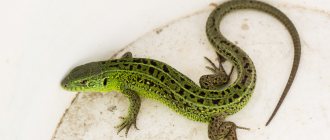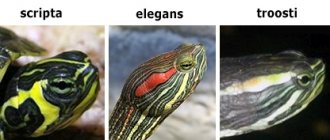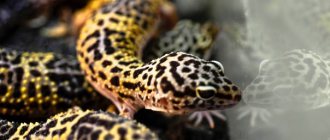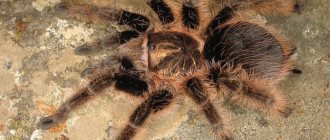Agile lizards in their natural environment
As already noted, these lizards are characterized by a fairly large habitat; they inhabit the territory of Russia up to South Karelia, the south of the Arkhangelsk region, the Komi Republic, Ugra and are found in the Western Baikal region.
However, common lizards live not only in Russian spaces, but also in Southern England, Eastern France, Poland, the Baltic States, Belarus, Ukraine and other former Soviet republics.
These animals settle in dry areas well warmed by the sun's rays - flat and mountainous, but not higher than one and a half kilometers. They create pairs and hide in secluded places at night - in burrows, under snags or boulders. Lizards also use similar shelters for wintering.
Accommodation
The sand lizard is distributed throughout Russia, starting from the western and northern borders of the Baikal region and ending with the southern Transbaikalia in the eastern part of the country.
Populations of lizards can be found in France, England, the Baltics, Georgia, Belarus, Ukraine, Armenia, and Azerbaijan.
In the south of Russia you can more often find green fast lizards with admixtures of blue and yellow colors. The belly of representatives of common lizards has a yellow-green tint.
Important! The exception to its habitat is the northern latitudes of the Moscow region, the Iberian Peninsula, some parts of Great Britain, Italy, Turkey and Greece (only adapted orders are found).
Appearance of a sand lizard
The length of individuals from the nose to the end of the tail is about 24-28 cm. Outwardly, they resemble tailed amphibians, but have a more slender physique.
External data
Lizards have the following structure:
- They have a small head , turning into a pointed muzzle, on which there are two wide-open nostrils. The neck is shortened and quite massive.
- The eyes are covered with eyelids, a transparent or translucent membrane. It is called the “third eyelid” and provides hydration to the eye membranes.
- Behind the eyes there are round eardrums - something, and these animals have excellent hearing.
- fork at the end, acts as an organ of touch. You can catch the lizard exploring various objects when it sticks out its tongue and runs it over surfaces.
- The limbs of the lizard look like frog legs, each of them has 5 thin fingers with tenacious claws. Animals use them for climbing. But they do not have membranes.
- Body covered with dry skin with horny scales. On the face and tummy the scales are larger, resembling large shields.
As they mature and increase in size, lizards begin to shed. This process is not frequent, occurring on average once every 4 years. They breathe only with their lungs; animals have no other respiratory organs.
Colors
As for coloration, males have quite a lot of variations - from light greenish to almost black tones. In the south, green lizards are more common. During courtship with females, males acquire brighter colors.
Females cannot boast of either brightness or variety of colors, although their gray or brown body is covered with bizarre patterns. The young have a body of the same tone, only the back is decorated with three stripes.
How to distinguish a female from a male
There's nothing complicated about it. There are a large number of color options for the stronger sex (males). Most often, their skin can be of these colors:
- Black.
- Blue.
- Light green.
- Green.
- Olive.
During their reproduction, males acquire a brighter color than in the period before mating.
Female individuals can be of two colors:
- Brown.
- Gray.
The color of females cannot be monochromatic; most often they have black patterns along the body. Females, unlike males, are smaller, with a yellowish or white belly. In any case, the color of the male is many times more spectacular than the color of the female. The differences are noticeable to the naked eye! The only difficulty in determining sex is that the young are dark in color with three white stripes on the dorsal part.
Rice. 4. Laying eggs
Temperament and livability of nimble lizards
Lizards live in burrows that they dig themselves, or they occupy someone else’s abandoned housing. Most often, they do not move far from him, they even hunt 10-15 meters from the house. When a threat arises, the animal begins to run away, randomly changing directions, thereby causing the attacker a feeling of confusion.
Lizards are most active during the day. They have excellent physical characteristics and extraordinary endurance, which is why they got their name - quick. They can run very fast, jump, climb well, and are capable of abruptly changing their trajectory even at high speed. It costs such tricksters nothing to catch a fly on the fly.
In addition, they behave very carefully and never let their guard down. Any sound, even a faint one, makes the lizard want to hide, and it quickly scurries into a hole or quickly climbs up branches. If, while chasing a lizard, the offender manages to grab its tail, it can escape by throwing away a piece of it.
In response to pain, one of the vertebrae breaks in the middle, and the animal does not bleed, since the mechanism of contraction of the muscle tissue around the wound is triggered. Then an intensive regeneration process occurs, and the fallen part of the tail grows back. True, it is not so long, and its color differs from the general color. But thanks to this reflex, the creature manages to save life.
Regeneration ability
The lizard's body bends when it crawls and, with the help of its claws, clings to the slightest irregularities in the ground or bark. An animal can climb a tree trunk or a rocky slope. In addition to the speed of movement, there is a protective coloring that is in harmony with the natural habitat. Some species have acquired the ability to change skin tones, while others hiss threateningly, scaring away predators. The thick, muscular tail aids in movement and protects against attack. There is an interesting property that lizards have. When the pursuer attacks them from behind and holds them by the tail, it easily breaks off and continues to squirm for some time. The attacker is fascinated by this movement, and the lizard escapes into a hole or thickets of grass. Instead of the lost one, the animal regenerates (restores) a new tail, shorter and thicker than the previous one.
New pet at home - what to do
Even a beginner understands that a lizard is not the most common pet, and it requires special care. What to do if such living creatures appear in the house?
- First of all, you should examine the lizard for parasites - often mites settle on their skin, which are easily detected due to their bright coloring. As a rule, such parasites do not pose a danger to people, but they cause discomfort in the lizard and can even cause its death.
- The pet should be placed in a quarantine tank for 14-21 days.
- It is recommended to carry out deworming using special products intended for reptiles.
Terrarium equipment
A lizard cannot live in a jar or box, so for a comfortable living it will need a properly equipped terrarium:
- for one individual, a tank measuring 40x60x40 cm is sufficient;
- the container should have a door located in the side wall - the lizard will not perceive an intrusion every time as an attempt to attack, and there will be much less stressful situations;
- a lizard can live in a spacious aquarium with low walls - but no drawers or boxes!
Temperature maintenance
The owner needs to take care of the microclimate - he should equip the lizard’s home with a thermometer and monitor the indicators, even at night. It is advisable to equip the tank in such a way that it has 2 zones - hot (34°-36°C) and cold (not lower than 30°C). At night, the thermometer should not fall below +21°C, otherwise the animal’s metabolic processes slow down, activity decreases, and some individuals begin to prepare for hibernation.
To maintain the temperature, it is best to use special devices that can be purchased at any pet store. The following devices are suitable for terrariums:
- lamps - they come in a variety of varieties: mirror, incandescent, halogen, etc.;
- Thermal stones are artificial minerals that, when turned on, heat the tank and are an excellent decoration for it. There is only one drawback - they can heat up to higher levels than stated;
- thermal cords - they are used to heat the lower part of the terrarium, stretching under containers or inside;
- thermal mats - used in the same way as the previous device.
Literature
- Fast lizard. Monographic description of the species / Ed. A. V. Yablokova. - M.: “Nauka”, 1976. - 376 p.
- Ananyeva N. B., Orlov N. L., Khalikov R. G., Darevsky I. S., Ryabov S. A., Barabanov A. V.
Atlas of reptiles of Northern Eurasia (taxonomic diversity, geographic distribution and conservation status). - St. Petersburg: Zoological Institute of the Russian Academy of Sciences, 2004. - P. 103. - 1000 copies. — ISBN 5-98092-007-2. - Orlova V.F., Semenov D.V.
Nature of Russia: the life of animals. Amphibians and reptiles. - M.: "LLC Firm "AST Publishing House", 1999. - P. 237-247. — 480 s. — 10,000 copies. — ISBN 5-237-01809-2. - Shimkevich V.M.
Quick lizard // Encyclopedic Dictionary of Brockhaus and Efron: in 86 volumes (82 volumes and 4 additional). - St. Petersburg, 1890-1907.
Other indicators for pet comfort
Stable temperature is not the only requirement for living conditions for a lizard:
- Ultraviolet rays - the pet needs sunlight, for this it is recommended to equip the terrarium with a UV lamp (5% marking). It must be turned on constantly and replaced every 6 months. If there is a deficiency of ultraviolet radiation, the animal’s body cannot fully absorb calcium, bone tissue is destroyed, and the pet dies in agony.
- Humidity control – it is recommended to install a small reservoir of water in the lizard’s home, into which it can climb on its own, and it is placed in a cool area. In addition, you can spray the interior surfaces of the terrarium daily or use moistened sponges. It is important to avoid excessive humidity, as fungi often grow in such conditions. You can avoid such a nuisance by ensuring good ventilation.
- Decor - the pet needs shelter and a pond, you can also mark twigs and snags on which the lizard will climb.
- Soil - it is placed at the bottom of the tank; any material intended for these purposes can be used. Only small shavings and sand are not suitable, as they can penetrate with food into the animal’s gastrointestinal tract and provoke various kinds of problems.
What problems might you encounter?
Most often, an iguana can get sick for two reasons:
- Binge eating
. The activity of the individual will be reduced, reproduction will become impossible, the animal will not be able to “molt”, will get sick and will soon die. The problem cannot be solved by completely eliminating food. On the contrary, it should be given by gradually reducing the amount of food, increasing lighting and temperature heating. All these manipulations should normalize metabolic processes for the lizard to fully function. - Malnutrition.
The animal is not allowed to starve for 2-4 weeks without a period of rest. Without food, the body is severely depleted, and the animal may also die. Malnutrition in a reptile will be indicated by a thin body, loose skin, a tight tail, decreased or, conversely, increased activity, and aggression toward everything that happens. In this case, it is contraindicated to give the lizard a lot of food at one time! It would be more correct to introduce only a few insects into the diet. Only a gradual increase in portions can help the animal survive. It is also necessary to increase lighting and increase humidity in the terrarium.
Important! If you need to leave home for several weeks and leave your lizard at home, reduce the temperature in the reptile's home to 20 °C and turn off the lighting. This way you will keep it active, thanks to energy reserves that will be consumed more slowly. Just don't forget to leave water for the animal!
Rice. 9. Lizard Child
What to feed a fast pet
In their natural environment, lizards successfully hunt beetles, grasshoppers, earthworms, caterpillars and spiders, so when choosing a home diet, you should give preference to live food. Some lizard owners start catching insects for their pet, but it is worth considering that the “dinner” caught in this way may be infected with parasites.
It is much easier and safer to purchase live food at a pet store - many of them sell crickets and cockroaches. With pleasure, lizards eat mealworm larvae, tobacco hawk moths, and locusts. You can rarely give your pet meat - raw lean beef or boiled chicken, a boiled egg. Before serving, the products are crushed. When feeding a sand lizard, you should adhere to certain rules:
- the diet should not consist of the same food, for example, eating only worms can cause obesity in the lizard;
- You should periodically include special nutritional supplements in your pet’s menu, which are available in powder form;
- feeding should be daily - in summer food is given three times, in winter - twice;
- one serving should consist of 5-10 insects;
- Adults cope well with food on their own, but young animals can be helped by using tweezers to feed them.
All insects that have not become food for the inhabitant should be removed from the tank, since there have been situations where grasshoppers and crickets have caused damage to the skin of sleeping “predators”. It is important to avoid both overeating and undernutrition; in both cases, owners face serious problems - their charges get sick and most often die.
Organ systems
Respiratory
Breathing is only pulmonary. The breathing mechanism is of the suction type (breathing occurs by changing the volume of the chest), more advanced than that of amphibians. Conducting airways (larynx, trachea, bronchi) are developed. The inner walls and septa of the lungs have a cellular structure.
Blood
The heart is three-chambered, consisting of two atria and one ventricle. The ventricle has an incomplete septum. The systemic and pulmonary circulations are not completely separated, but the venous and arterial flows are more clearly separated, so the body of reptiles is supplied with more oxygenated blood.
The right atrium receives venous blood from all organs of the body, and the left atrium receives arterial blood from the lungs. When the ventricle contracts, its incomplete septum reaches the dorsal wall and separates the right and left halves. From the left half of the ventricle, arterial blood enters the vessels of the brain and the anterior part of the body; from the right half, venous blood goes to the pulmonary artery and further to the lungs. The trunk region receives mixed blood from both halves of the ventricle.
Nervous
The brain is more developed, especially the forebrain hemispheres (responsible for complex instincts), the optic lobes and the cerebellum (coordinator of movements).
Sense organs
Sense organs are more complex. The reptile's eyes distinguish between moving and stationary objects. The lens in the eyes can not only move, but also change its curvature. Lizards have movable eyelids. In the olfactory organs, part of the nasopharyngeal passage is divided into olfactory and respiratory sections.
The internal nostrils open closer to the throat, so reptiles can breathe freely when they have food in their mouths.
Do lizards overwinter in captivity?
Not all owners of such unusual pets provide their charges with suitable conditions for hibernation. However, it is of great importance for the life of lizards:
- individuals that do not hibernate do not reproduce, since the mechanisms influencing the mating instinct do not operate;
- “not sleeping” males become dull during the winter period, while in the spring the color intensity is not restored;
- without hibernation, animals become less active;
- Life expectancy becomes shorter, pets are more often exposed to various diseases.
How to put your pet into hibernation and bring it out of it
This process is quite painstaking, but necessary:
- 3-4 weeks before wintering it is necessary to feed your pet more nourishingly and variedly;
- then the lizard is not given food for 12-14 days so that its intestines are cleansed;
- then you should gradually or stepwise (4°-5°C) lower the temperature in the tank. The duration of each stage is 3-7 hours;
- the ideal indicator for wintering is +5 +7C;
- You can place the lizard in a small container that has holes for air to enter and place it in the refrigerator - provided that it is possible to regulate the temperature in it.
It is worth knowing that hibernating lizards breathe approximately 2 times per minute, and it is almost impossible to detect their heartbeat. Therefore, before saying goodbye to an allegedly dead pet, you should make sure that it is not sleeping. The lizards are brought out of hibernation by gradually increasing the ambient temperature. Then it is important to provide ultraviolet light and good heating.
In the first three days, the individual can only lie down and bask, without showing much activity and refusing to eat. It is not recommended to force feed her. If everything was done correctly, the lizard will soon recover and begin to molt. Wintering lasts from 1 to 4 months. The duration of this period is determined by the following factors:
- if the lizard sleeps for less than 4 weeks, then you can expect the same problems as in the complete absence of hibernation;
- when this period drags on longer than expected, the individual experiences severe exhaustion and dies without waking up or during exit.
Literature
- Fast lizard. Monographic description of the species / Ed. A. V. Yablokova. - M.: “Nauka”, 1976. - 376 p.
- Ananyeva N. B., Orlov N. L., Khalikov R. G., Darevsky I. S., Ryabov S. A., Barabanov A. V.
Atlas of reptiles of Northern Eurasia (taxonomic diversity, geographic distribution and conservation status). - St. Petersburg: Zoological Institute of the Russian Academy of Sciences, 2004. - P. 103. - 1000 copies. — ISBN 5-98092-007-2. - Orlova V.F., Semenov D.V.
Nature of Russia: the life of animals. Amphibians and reptiles. - M.: "LLC Firm "AST Publishing House", 1999. - P. 237-247. — 480 s. — 10,000 copies. — ISBN 5-237-01809-2. - Shimkevich V.M.
Quick lizard // Encyclopedic Dictionary of Brockhaus and Efron: in 86 volumes (82 volumes and 4 additional). - St. Petersburg, 1890-1907.
Peculiarities of reproduction of agile lizards
First of all, by looking at the male, you can find out about his readiness to mate. He lifts his body off the ground and begins to look around, looking for a potential “bride.” Having discovered a suitable individual, he pursues it. If the “race” is completed successfully, and the female falls into his arms, he, holding the base of her tail with his mouth and her body with his paws, begins to mate.
After some time, the female lays a clutch, burying 6-16 fairly large eggs in a small hole. All stages of the development of the offspring occur in the egg, and an independent young individual is born. Particularly large and confident males are capable of eating young.
Sandy lizards are perfectly adapted to living in the natural environment, which confirms their wide distribution and the presence of numerous populations. However, in order for such a pet to feel comfortable in captivity, the owner needs to try. Of course, these inhabitants are not too whimsical compared to other lizards and amphibians, but they need suitable conditions.
All the efforts made will pay off with interest - active and agile lizards will delight children and adults with their liveliness, interesting behavior and charisma. It is almost impossible to pass by the terrarium where this animal lives and not stop.










